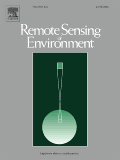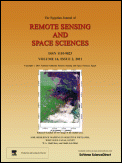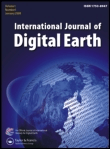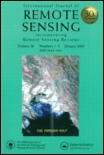
REMOTE SENSING OF ENVIRONMENT
Scope & Guideline
Bridging Technology and Nature through Remote Sensing.
Introduction
Aims and Scopes
- Remote Sensing Technology and Methodologies:
The journal emphasizes the development and application of advanced remote sensing technologies, including satellite imagery, UAV (drone) data, and LiDAR. It explores new algorithms and models for extracting meaningful environmental information from these technologies. - Environmental Monitoring and Assessment:
Research published in the journal often focuses on monitoring environmental changes, such as deforestation, land degradation, and climate change impacts through multi-temporal satellite data analysis. - Biophysical Parameter Retrieval:
A significant focus is on retrieving biophysical parameters (e.g., vegetation indices, biomass, chlorophyll content) from remote sensing data, which are crucial for understanding ecosystem health and productivity. - Integration of Remote Sensing with Ground Data:
The journal promotes research that integrates remote sensing data with ground-based measurements to validate and enhance the accuracy of remote sensing-derived information. - Climate and Hydrological Studies:
Papers often investigate the interactions between climate variables and hydrological processes, utilizing remote sensing to study phenomena such as evapotranspiration, drought, and water resources management. - Urban and Land Use Studies:
The journal includes research on urbanization effects, land use change detection, and the implications of these changes on local and global scales, using high-resolution satellite imagery.
Trending and Emerging
- Machine Learning and AI Applications:
The use of machine learning and artificial intelligence in processing and analyzing remote sensing data is on the rise. This includes applications for classification, regression, and prediction tasks across various environmental domains. - High-Resolution Remote Sensing:
There is a growing trend towards using high-resolution satellite imagery and UAV data for detailed environmental monitoring, allowing for fine-scale analyses of changes in ecosystems and urban areas. - Climate Change Impact Studies:
Research focusing on the impacts of climate change is increasingly prominent, with remote sensing being used to monitor changes in land cover, temperature anomalies, and shifting ecological patterns. - Integration of Remote Sensing and Citizen Science:
Emerging studies are combining remote sensing with citizen science data to enhance environmental monitoring efforts, particularly in areas like biodiversity and land use changes. - Focus on Carbon Dynamics and Greenhouse Gas Emissions:
There is an increasing emphasis on quantifying carbon dynamics and greenhouse gas emissions using remote sensing techniques, reflecting the urgency of addressing climate change.
Declining or Waning
- Traditional Land Cover Mapping Techniques:
There seems to be a decline in the use of conventional methods for land cover classification, as more advanced machine learning and deep learning techniques become prevalent, offering better accuracy and efficiency. - Low-Resolution Remote Sensing Applications:
Applications relying on low-resolution satellite data are becoming less frequent, as researchers increasingly focus on high-resolution and multi-source data for more detailed analyses. - Empirical Models Without Integration of Remote Sensing:
There is a noticeable decrease in studies that rely solely on empirical models without incorporating remote sensing data, as the integration of remote sensing with modeling is now more favored. - Single-Sensor Studies:
Research focusing exclusively on a single type of remote sensing data (e.g., only Landsat or MODIS) is declining in favor of studies that leverage multi-sensor data to improve the robustness of findings.
Similar Journals

Science of Remote Sensing
Innovating Remote Sensing for a Sustainable FutureScience of Remote Sensing, published by Elsevier, is a premier open-access journal that has been at the forefront of interdisciplinary research since its inception in 2020. With an impressive impact factor and its status in the Q1 quartile category for both Earth and Planetary Sciences and Forestry, this journal effectively caters to a diverse audience, including researchers, professionals, and students interested in the latest developments in remote sensing technologies and their application across varied domains. Located in the Netherlands, the journal provides a collaborative platform for scientific discourse, ensuring that impactful research is easily accessible to the global community. As it converges its focus through to 2024, Science of Remote Sensing continues to promote innovation and excellence, establishing itself as a vital resource for advancing knowledge in both the agricultural and environmental sectors. With a robust ranking (Rank #6 in Forestry and Rank #8 in General Earth and Planetary Sciences), it is well-positioned to contribute significantly to ongoing scientific advancements.

Jokull
Charting the Course of Climate ResearchJokull is a distinguished journal published by the ICELAND GLACIOLOGICAL SOC, dedicated to advancing knowledge in the field of Earth and Planetary Sciences. Since its inception, Jokull has served as a vital platform for the dissemination of research findings pertaining to glaciology, geomorphology, and related environmental studies, with a rich history spanning from 1980 to 2021. Although the journal's coverage has been discontinued in Scopus, it remains an important resource for academics and practitioners interested in Iceland’s unique geography and climate dynamics. Classified in the Q4 category in the 2023 rankings of Earth and Planetary Sciences, it stands as a testament to the evolving discourse in this vital field of study. Researchers and professionals looking to contribute to or engage with pioneering research are encouraged to explore the insights and findings shared within these pages, even in the absence of open access options. With its headquarters in Reykjavik, Iceland, Jokull continues to facilitate critical discussions and collaborations that shape our understanding of the planet's changing environments.

Journal of Geovisualization and Spatial Analysis
Charting New Territories in Spatial AnalysisJournal of Geovisualization and Spatial Analysis, published by SpringerNature, is an influential open-access journal specializing in the cutting-edge fields of geovisualization, spatial analysis, and their application in earth sciences and geography. Since its inception in 2017, this journal has established a prominent stance with a high impact factor and prestigious Q1 rankings across multiple categories, including Computers in Earth Sciences, Earth and Planetary Sciences (miscellaneous), and Geography, Planning and Development. The editorial board is committed to advancing innovative research and methodologies, providing a platform for scholars to disseminate their findings globally. With impressive Scopus rankings—placing it in the top percentiles among its peers—the journal serves as a vital resource for researchers, professionals, and students keen on understanding spatial data and its implications for geographic science. Its emphasis on rigorous peer review and rapid publication enhances accessibility to substantive research, thus fostering knowledge sharing within the scientific community. Based in Switzerland, the journal promotes a collaborative environment for interdisciplinary studies, making it an essential read for anyone involved in spatial analysis research.

Remote Sensing
Transforming Data into Insight: The Future of Remote SensingRemote Sensing is a highly esteemed journal published by MDPI, dedicated to the domain of Earth and Planetary Sciences. With an impressive impact factor reflected in its rank of #16 out of 195 in the general Earth and Planetary Sciences category, this journal achieves a commendable 92nd percentile among its peers, indicating its significant contribution to the field. Since its inception in 2009 as an Open Access journal, it has enabled researchers, professionals, and students from around the globe to access high-quality, peer-reviewed articles that delve into the latest advancements in remote sensing technologies, methodologies, and applications. Based in Switzerland, Remote Sensing serves as a vital platform for disseminating innovative research that supports and enhances our understanding of Earth's processes and environments, ensuring scientific knowledge remains freely accessible and impactful.

Egyptian Journal of Remote Sensing and Space Sciences
Empowering Researchers with Open Access to Groundbreaking DiscoveriesThe Egyptian Journal of Remote Sensing and Space Sciences, published by Elsevier, is a premier open-access journal dedicated to advancing the fields of Remote Sensing and Space Sciences. Since its inception, the journal has gained a prominent reputation, currently holding a prestigious Q1 ranking in Earth and Planetary Sciences and placing within the top 10% of its field according to Scopus metrics. With an ISSN of 1110-9823 and an E-ISSN of 2090-2476, the journal features a diverse range of scholarly articles that explore both theoretical and practical aspects of remote sensing technologies and space science innovations, thus appealing to researchers, professionals, and students alike. Established in 2003 and fully transitioning to an open-access model in 2010, the journal aims to disseminate knowledge and foster collaboration across the globe by providing wider accessibility to groundbreaking research findings. Its commitment to quality and innovation is a catalyst for intellectual development in these dynamic and evolving disciplines.

International Journal of Digital Earth
Fostering collaboration in the realm of digital Earth sciences.Welcome to the International Journal of Digital Earth, a premier open-access journal published by Taylor & Francis Ltd, dedicated to advancing the field of digital geoscience. With its ISSN 1753-8947 and E-ISSN 1753-8955, this journal has established itself as a vital resource for scholars and practitioners alike since its inception in 2008. The journal is at the forefront of interdisciplinary research, showcasing a diverse scope from Earth sciences to computer science applications, evidenced by its impressive ranking in the 2023 Scopus database. It holds a Q1 categorization in Earth and Planetary Sciences, with a percentile rank among the top 16% of its peers, and also stands out in the Q2 quartile for both Computer Science Applications and Software disciplines. The journal's commitment to open access, established in 2022, underscores its dedication to disseminating knowledge and fostering collaboration. By providing a platform for high-quality research, the International Journal of Digital Earth plays a critical role in addressing the complexities of our changing planet through innovative digital solutions. Whether you are an experienced researcher or a student, this journal is an essential addition to your academic toolkit.

INTERNATIONAL JOURNAL OF REMOTE SENSING
Transforming Data into Insights for a Sustainable FutureInternational Journal of Remote Sensing, published by Taylor & Francis Ltd, stands at the forefront of Earth and Planetary Sciences, providing a critical platform for disseminating pioneering research since its inception in 1980. With an impressive ranking of #25 out of 195 in general Earth and Planetary Sciences and a notable 87th percentile on Scopus, this journal is recognized for its high-quality contributions that span diverse topics including satellite imagery analysis, geospatial technologies, and environmental monitoring. As a Q1 journal in its field for 2023, it offers invaluable insights and methodologies that are essential for researchers, professionals, and students alike. Although not Open Access, the journal facilitates a comprehensive understanding of remote sensing sciences, ensuring that the scholarly community remains updated with the latest advancements, trends, and applications that impact global challenges.

Journal of Remote Sensing
Exploring New Frontiers in Earth and Planetary SciencesThe Journal of Remote Sensing is a leading scholarly publication dedicated to advancing knowledge and research in the field of remote sensing. Published by the American Association for the Advancement of Science, this open-access journal, which has been available since 2021, strives to provide an inclusive platform for researchers, professionals, and students alike to share transformative findings and innovative techniques related to Earth and planetary sciences, as well as their applications in social sciences and geography. With impressive Scopus rankings, placing it in the 94th percentile for Earth and planetary sciences and the 93rd percentile in geography, the journal is recognized for its high-impact contributions to the field. Researchers can access invaluable content without barriers, ensuring that the latest advancements in remote sensing technology and methodologies are widely disseminated and utilized. By fostering interdisciplinary collaboration and promoting high-caliber research, the Journal of Remote Sensing is becoming an essential resource for anyone interested in the intersection of technology and environmental studies.

Remote Sensing in Ecology and Conservation
Pioneering open-access research to protect our planet's biodiversity.Remote Sensing in Ecology and Conservation is a pioneering journal published by WILEY that has been a beacon of open-access research since 2015. With an E-ISSN of 2056-3485, this journal stands at the forefront of the intersection between ecological research and technological innovation. It is recognized for its significant impact, boasting Q1 rankings across several prestigious categories in 2023, including Computers in Earth Sciences and Ecology, emphasizing its commitment to high-quality, influential scholarship. The journal provides a platform for researchers and practitioners to share their findings in remote sensing applications that advance ecological conservation efforts. Encompassing a broad scope that includes studies on landscape changes, biodiversity assessments, and environmental monitoring, it serves as an essential resource for education and practice in the field. With impressive ranks in Scopus, including a remarkable 6th place in Earth and Planetary Sciences, it continues to shape the dialogue in ecology and conservation. As an open-access journal, it champions the dissemination of knowledge, making critical research accessible to a global audience, thereby fostering innovation and collaboration in the pursuit of sustainable environmental practices.

Geomatik
Advancing geomatics for a sustainable future.Geomatik is a pioneering open-access journal dedicated to advancing the field of geomatics, encompassing disciplines such as geospatial data analysis, remote sensing, and geographic information systems. Founded in 2016 by the esteemed Geomatik Journal publisher, this peer-reviewed platform aims to disseminate high-quality research and innovative methodologies to a global audience. With its E-ISSN 2564-6761, Geomatik facilitates accessibility to cutting-edge studies that address vital challenges in environment monitoring, urban planning, and spatial data management. The journal not only encourages collaboration among researchers and practitioners but also serves as an essential resource for students seeking to deepen their understanding of geomatic sciences. Its commitment to open access fosters scholarly exchange and enhances visibility for authors, contributing to significant advancements within the geomatics community.